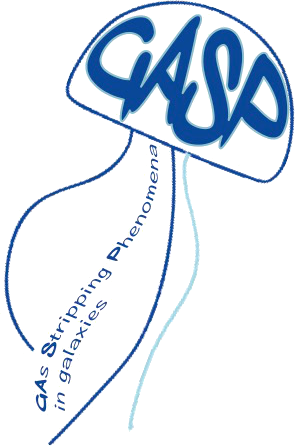The GASP project
GASP (GAs Stripping Phenomena in galaxies with MUSE) is a new integral-field spectroscopic survey with MUSE at the VLT aiming at a detailed investigation of gas removal processes in galaxies.
The goal of this project is to significantly improve our understanding of gas removal processes from galaxies in different environments.
It collects data for a statistically significant sample of stripped candidates selected from the cluster samples WINGS (Fasano et al. 2006, Moretti et al. 2014) and OmegaWINGS (Gullieuszik et al. 2015, Moretti et al. 2017) and the general field sample PM2GC (Calvi et al. 2011), with a range of galaxy masses and different degrees of optical evidence for gas stripping, in the different environments.
The 2-D maps of stellar and gas kinematics, together with the resolved stellar population properties obtained with MUSE will permit to understand the physics of the gas stripping and the consequent quenching of the star formation.
The key drivers of GASP are:
- measure the time-scale and the efficiency of the stripping phenomenon in galaxies as a function of galaxy environment and galaxy mass;
- quantify the amount of stars formed in the stripped gas, contributing to the understanding of the formation of the intracluster and intragroup medium;
- estimate the speed at which the galaxy moves in the IGM from the comparison between the velocity of the stripped gas and that of the main galaxy body;
- identify the physical process/es responsible for the gas outflow among the possible external (ram pressure, tidal interactions, harassment, etc.) and internal (winds due to stars or AGN) mechanisms, clarifying where and how it happens;
- monitor the evolution of the galaxies which are being depleted of their gas content, looking at their transition from the blue cloud to the red sequence;
- derive the galaxy velocity and velocity dispersion maps, measure the total mass and Mass/Light ratio and estimate the spatially resolved star formation history and metallicity distribution.
An overview of the sample can be found here
